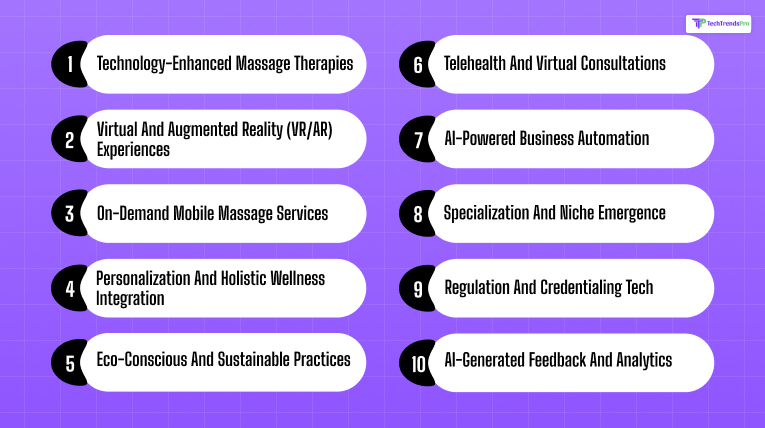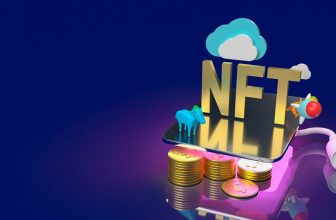
The massage therapy industry, a sector that traditionally has been linked with healing, relaxation, and wellness, is at a crossroads.
Prodded by revolutionary technologies, changing customer needs, and a fresh emphasis on holistic well-being, the massage industry is on the cusp of an age of great promise and tremendous innovation.
From AI-assisted massage robots to virtual consultations and personalized wellness plans, the landscape is shifting rapidly.

In this article, we’ll dive deep into the emerging trends and technologies that are shaping the future of the massage industry, and what massage professionals and business owners need to do to stay ahead of the curve.
1. Technology-Enhanced Massage Therapies
AI and Robotics Integration
Massage robots existed years ago, but AI-driven massage robots are transforming the market. Such robots apply machine learning algorithms and sensor inputs to simulate human touch, capture user patterns, and deliver predictable, on-demand treatment.
Major Features:
- Calibration of pressure sensitivity
- Programmable massage routines
- Intelligent posture and tension detection
- Real-time adjustment and feedback
Impact for the Future: While they will not replace trained therapists, these robots can be used as an additional tool for clinics, spas, and even home use, providing affordable, easy-to-access care.
Integration Of Wearable Health Trackers
Products such as Apple Watch and Fitbit are being incorporated into massage therapy treatments. Having heart rate, stress, and sleep activity data available, therapists can design sessions to accommodate the immediate physiological state of the clients.
Advantages:
- Evidence-based treatments
- Early identification of chronic stress or muscle problems
- Customized recovery plans
Future Impact: Look for more data-based therapy plans, enhancing the precision of treatment and client satisfaction.
2. Virtual And Augmented Reality (VR/AR) Experiences
VR Meditation And Relaxation Pods
Certain spas and wellness centers are now presenting VR experiences alongside massage therapies. These simulated environments can send the client to serene beaches or quiet forests, incorporating an added sensory and emotional aspect to the massage therapy.
AR For Therapist Training
AR is revolutionizing massage therapist training. Through the use of augmented overlays on models of anatomy, therapists can be taught muscle groups, trigger points, and techniques in a highly interactive, real-time environment.
Future Impact: AR and VR will be key technologies in both client experience enhancement and professional training.
3. On-Demand Mobile Massage Services
Uberization Of Massage Therapy
The emergence of mobile platforms such as Soothe, Zeel, and Urban Massage is now enabling bookings than ever for in-home, office, or hotel massages with a few taps.
Trending Highlights:
- 24/7 on-demand access
- Review, tip, and subscribe in-app
- Easy gig-economy-like relaxed scheduling for therapists
Impact In the Future: More massage businesses will embrace mobile-first practices, with the rollout of mixed-mode services combining in-spa appointments and on-site visits.
4. Personalization And Holistic Wellness Integration
Personalized Wellness Plans
Clients aren’t merely seeking relaxation. They’re in search of complete wellness solutions that fit their lifestyles and ambitions. Massage clinics are transforming into holistic wellness centers providing services such as:
- Massage + Nutritional Counseling
- Massage + Yoga Therapy
- Massage + Chiropractic and Acupuncture
Technology Integration: AI-powered health questionnaires and biometric screenings will enable therapists to provide tailor-made treatment programs.
5. Eco-Conscious And Sustainable Practices
Green Spas on the Rise
Green consumers are pushing demand for environmentally conscious services. Look for more massage businesses to feature:
- Organic oils and lotions
- Recyclable or biodegradable packaging
- Energy-efficient lighting and water-conserving equipment
- Green certifications and eco-labels
Future Impact: Not only will sustainability be a marketing plus, but it will be an imperative to engage with a new generation of aware consumers.
6. Telehealth And Virtual Consultations
Although physical massage cannot be replicated online, the consultation and follow-up process absolutely can.
How It Works:
- Pre-treatment screening through video
- Lifestyle and ergonomics consultations
- Post-treatment stretching/mobility sessions via video
Future Impact: These virtual connections will enable therapists to take their business off the table, retain clients, and generate repeat revenue with virtual coaching.
7. AI-Powered Business Automation
Smart Scheduling and CRM
Artificial intelligence is also changing how massage businesses operate. Advanced CRM software can now:
- Forecast peak appointment times
- Send automatic reminders and follow-up
- Segment customer interests
- Staff and therapist rotation for more efficient scheduling
Real-time Customer Support through Chatbots
Natural language processing-enabled chatbots can schedule appointments, answer frequently asked questions, and even provide treatment modality recommendations based on customer feedback.
Future Impact: Automated business will assist in reducing overheads, allowing therapists to concentrate on high-quality care.
8. Specialization And Niche Emergence
In order to differentiate from the competition, clinics and therapists look for high-in-demand niches like:
- Sports massage for sportsmen
- Pregnancy and post-baby massage
- Geriatric massage for geriatrics
- Trauma-informed bodywork
- Lymphatic drainage after surgery
Data-Driven Insights:
Niche services can be validated with customer reviews, fitness tracking information, and recovery monitoring, double-improving results, and loyalty.
Future Impact: Specialization will be unavoidable as consumer sophistication increases and demand becomes smarter.
9. Regulation And Credentialing Tech
Blockchain for Licensing and Certification
Unqualified practitioners and fraud being threats, blockchain tech can be applied to authenticate credentials, monitor ongoing education, and protect client records in a tamper-proof manner.
Future Impact: Expect to see an increase in tech-enabled credential validation, driving increased transparency and trust within the profession.
10. AI-Generated Feedback And Analytics
Post-Session Reports
Emerging tools are providing session analytics, including muscle tension feedback, pressure sensitivity, and improvement over time, especially with robotic or sensor-based systems for massage.
Client Portals
These sites allow clients to track wellness paths, schedule follow-up sessions, and change preferences—all while giving companies insight into satisfaction and retention.
Future Impact: Data-driven feedback loops will fuel greater personalization and long-term engagement.
Key Takeaways For Business Owners Of Massage
| Actionable Strategy | Benefit |
| Invest in AI scheduling and CRM software | Save time and decrease no-shows |
| Provide hybrid mobile + in-clinic services | Increase market reach |
| Promote eco-friendly branding | Appeal to green-consumer-conscious buyers |
| Train staff in specialty massage techniques | Diversify your business |
| Leverage client data to personalize | Increase retention and upselling |
The Future Of Massage Therapy
The future massage practice is client-focused, high-tech, and dynamic. While healing touch will ever continue to be the core of massage therapy, the integration of emerging trends and technologies can energize client satisfaction, improve operations, and bring new revenue streams.
Adaptive therapists and entrepreneurs who are adept at using technology while being true to themselves and empathetic will thrive in this evolving environment.
Additionals:






